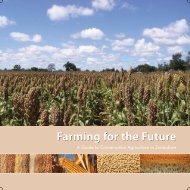68Green Manure/Cover Crop SystemsAfrican Green Manure/Cover Crop SystemsBurkina FasoS50 and S51. Millet and sorghum/nyama-1. Nyama (Piliostigma reticulatum) is aperennial bush native to <strong>the</strong> Sahel (see #45 for information on nyama). In this system,nyama leaves are carried from <strong>the</strong> bush to fertilize millet and sorghum in nor<strong>the</strong>asternBurkina Faso. We know that at least hundreds of farmers use this traditional system.S52. Millet/nyama-2. Nyama is allowed to volunteer in farmers’ fields. Just before <strong>the</strong>rains come, it is pruned down at ground level and <strong>the</strong> leaves are spread across <strong>the</strong> fieldto fertilize it. This traditional practice is used by thousands of farmers in both BurkinaFaso and Mali.GhanaS53. Maize/mucuna-9. This system is a simple rainy season intercrop of mucuna inmaize. The mucuna is intercropped late enough in <strong>the</strong> maize’s growing season so <strong>the</strong>maize is not overcome by <strong>the</strong> mucuna. In one area, <strong>the</strong> people were actually using<strong>the</strong> variety of mucuna that provokes severe itching, meaning <strong>the</strong>y couldn’t go near<strong>the</strong>ir fields for two months. They switched to <strong>the</strong> non-itchy mucuna immediatelyafter learning about it. Thousands of farmers use this traditional system. In addition,thousands—if not tens of thousands—use <strong>the</strong> same system in Benin and Oaxaca Statein Mexico.S54. Maize/nyama. At <strong>the</strong> end of <strong>the</strong> fallow period, when <strong>the</strong> fields are to be burned,<strong>the</strong> nyama bushes are cut and covered with dirt, so that less nitrogen will be burnedoff. Actually, this system was used traditionally for all local crops, but is disappearingas fallowing itself is disappearing in <strong>the</strong> Sahel. Quite likely almost no one is using thistraditional system today.S55. Maize/calopogonium. Calopogonium (Calopogonium mucunoides) is used inrotation with maize in parts of Ghana and neighboring countries. There are probablythousands of adopters. This system started being used after calopogonium was introducedinto <strong>the</strong> country. To <strong>the</strong> dismay of many farmers, calopogonium has become anoxious weed. This system is not recommended for use anywhere else.S56. Maize/leucaena. In ano<strong>the</strong>r interesting system, Leucaena leucocephala is intercropped(three seeds per square metre) in maize and allowed to grow <strong>the</strong> whole rainyseason. After <strong>the</strong> maize harvest, <strong>the</strong> field is burned lightly to kill <strong>the</strong> leucaena withoutburning away all <strong>the</strong> nitrogen. This is done in Benin (where <strong>the</strong> practice originatedand where it is apparently widely practiced) and sou<strong>the</strong>rn Ghana, where perhaps a fewhundred farmers use it.
Green Manure/Cover Crop Systems69MaliS57. Millet/Faidherbia albida. Farmers in Mali, Burkina Faso and Niger purposelyleave existing Faidherbia albida (previously Acacia albida) trees in <strong>the</strong>ir fields. Thesetrees, different from all <strong>the</strong> o<strong>the</strong>r Sahelian trees, drop <strong>the</strong>ir leaves during <strong>the</strong> rainy season,<strong>the</strong>refore supplying a very beneficial 15 to 25% shade to <strong>the</strong> crops under <strong>the</strong>m.This shade allows crops to keep on growing all day, instead of closing down during<strong>the</strong> excessive mid-day heat, <strong>the</strong>reby increasing productivity by up to 40%. The lowersoil surface temperature achieved by <strong>the</strong> shade also dramatically reduces evaporationand transpiration rates. As a result, soil moisture losses are reduced and <strong>the</strong> annualgrowing season is extended by a week or two. Farmers who practice this traditionalsystem probably number in <strong>the</strong> hundreds of thousands.S58. Millet/nyama-3. This is <strong>the</strong> only system in <strong>the</strong> decision tree that has never beenpracticed by any farmers exactly as described. But I believe it would be an ideal systemfor <strong>the</strong> African Sahel. I venture this bit of hubris for two reasons. First, <strong>the</strong> systemI am suggesting is basically a combination of two already-existing systems (S52 andS57). A fast-growing exotic tree and organized on a grid to make animal tractionplowing easier will reduce <strong>the</strong> labor requirement of <strong>the</strong> traditional systems.Second, <strong>the</strong> Sahel suffers from a lack of good gm/cc systems. This has happened inpart because of a widespread but mistaken belief that <strong>the</strong>y will not work under semiaridconditions. It also has happened in part because <strong>the</strong> environment in <strong>the</strong> Sahelis definitely somewhat hostile to all living things, especially gm/cc species, with <strong>the</strong>irhigh nitrogen, and <strong>the</strong>refore high protein content.Yet even in <strong>the</strong> nor<strong>the</strong>rn Sahel, two gm/cc systems are presently working very well.Farmer managed natural regeneration (FMNR) has populated some 5 million hectaresof Niger with trees, as well as ano<strong>the</strong>r half million hectares in nor<strong>the</strong>rn Mali. Sincea large number of <strong>the</strong>se trees are leguminous, <strong>the</strong> soil in this system has gained bothan increase in organic matter and an increase in nitrogen. Millet yields have increasedsignificantly. Ano<strong>the</strong>r system, developed by <strong>the</strong> Dogon around <strong>the</strong> town of Koro,involves leaving naturally occurring trees in <strong>the</strong> fields and protecting certain o<strong>the</strong>rdesired species of trees (such as Faidherbia albida) that sprout naturally in <strong>the</strong>ir fields.These trees are all pruned in <strong>the</strong> shape of a funnel, which prevents <strong>the</strong> area under <strong>the</strong>tree from getting too much shade, yet shades all <strong>the</strong> field at some time during <strong>the</strong> dayas <strong>the</strong> sun moves across <strong>the</strong> sky. Under this dispersed shade, <strong>the</strong> Dogon farmers practicea rotation that includes such gm/ccs as peanuts, Bambara groundnuts and fonio.Just as with FMNR, yields have increased as <strong>the</strong> organic matter content of <strong>the</strong> soil hasalso increased. The last time I visited this area, <strong>the</strong> Dogon farmers using this systemwere collecting <strong>the</strong> largest harvest <strong>the</strong>y had had in years, while everyone around <strong>the</strong>mfor many miles was complaining that <strong>the</strong> drought had destroyed <strong>the</strong>ir crops.For <strong>the</strong> sou<strong>the</strong>rn Sahel (from about 13 o N latitude towards <strong>the</strong> south), <strong>the</strong> gm/ccsystem that I would like to see tried more widely consists of dispersed shade providedby mo<strong>the</strong>r of cacao (Gliricidia sepium) and, if farmers wish, Faidherbia albida trees,
















